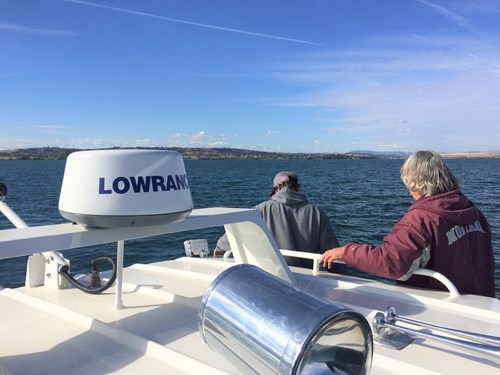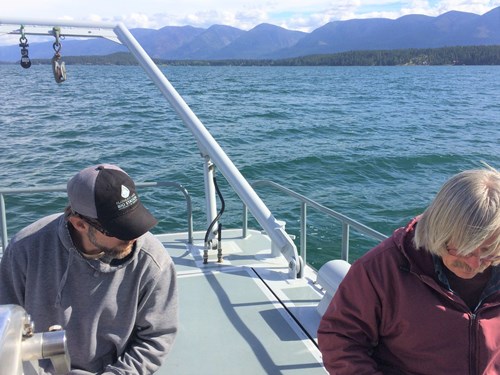Flathead Lake Biological Station Expands Monitoring Program to Include New Polson Bay Site
The University of Montana’s Flathead Lake Biological Station (FLBS) is adding a new long-term lake sampling site to its 40+ years of continuous research and monitoring in the Flathead. The new location is in Polson Bay to represent the lake’s southern basin.
Partners who helped make this new venture possible include the Flathead Lakers who made a financial leadership contribution and the Confederated Salish and Kootenai Tribes who granted a permit for the new monitoring site and who support additional data collection.
“We’re really excited about the Polson Bay monitoring site,” said FLBS Director Jim Elser. “It’s effectively a whole different lake down there, so we can imagine many new scientific insights and opportunities arising out of this effort.”
Serving as “Sentinel of the Lake”, FLBS has maintained a scientifically rigorous research and monitoring program in the Flathead watershed since 1977, and currently boasts one of the best long-term lake and river datasets in the world. This monitoring program keeps its finger on the pulse of the watershed and the lake, watching for changes before they become problems.
Although this FLBS research and monitoring program has sampled at 60+ sites spread around Flathead Lake and another 20+ within the river systems, few sites are visited frequently — most of the sampling sites are visited once each year (or less). Regular, monthly sampling in the lake has been conducted primarily at a single sampling site in the deepest part of the lake off Yellow Bay at a station known as “Mid-Lake Deep”. FLBS data show that this one mid-lake site represents well the conditions throughout the deep, open water portion of the lake, but it may not reflect conditions or capture negative changes in other areas of the lake such as near the shoreline or in the shallow south basin.

The Polson community will have a great view of the new Polson Bay monitoring site, which will be used by FLBS and CSKT to gather important data and protect against aquatic invasive species.
The idea for adding a second regularly-monitored site in Polson Bay has been around for a while, but limited resources always prevented it becoming a reality. Many other lakes—including smaller lakes and local lakes like Whitefish Lake—have maintained multiple monitoring sites.
Spurred by compelling spatial data gathered by citizen scientists involved in the FLBS and Flathead Lakers joint Flathead Lake Citizen Science Program’s inaugural event, the 2018 Flathead Lake Secchi Dip-In, researchers at FLBS felt it was time to add another sampling site to the FLBS water quality monitoring program. The addition of a new site would bring significant benefits to the program, including enhancing the Station’s already robust monitoring datasets and increasing the likelihood of early detection of aquatic invasive species.
“Adding the Polson Bay site to the Flathead Monitoring Program (FMP) will help us understand Flathead Lake’s ecology and dynamism like never before, as well as strengthen our ability to fulfill our role as stewards of the lake,” said Assistant Research Professor, Shawn Devlin, who oversees FLBS watershed monitoring. “The fact that the Flathead Citizen Science program and its enthusiastic participants’ hard work helped to facilitate the FMP expansion is inspiring. The Flathead Lake community is dedicated and passionate and, above all, very much appreciated by FLBS.”
The benefits and need for the new Polson Bay Monitoring Site have been discussed, endorsed, and permitted by the Confederated Salish and Kootenai Tribes.
“CSKT is honored to partner with the Flathead Monitoring Program,” said Ronald Trahan, Chairman of the Confederated Salish and Kootenai Tribes. “We have some of the finest employees who work to protect our waters, lands, fish, plants, and wildlife utilizing the best science available.”
Additionally, the site was made possible by a significant financial contribution from the Bio Station’s long-term partner, the Flathead Lakers. The remainder of the funding to get the new site started is from philanthropic support from the Bio Station’s generous community, especially shoreline homeowners.
“The Flathead Lakers are pleased to help support water monitoring by FLBS in Polson Bay,” said Flathead Lakers President Thomas Cox. “Early detection of any changes in water quality or the appearance of invasive species may allow intervention before it is too late. This is extremely important to the community of Polson and everywhere else around the lake.”
The Polson Bay Monitoring Site is located in the middle of Flathead Lake’s southern basin, almost directly between the shorelines of Polson and the chain of islands at “The Narrows.” Data collection began at the site in mid-April, and will continue throughout the summer and fall until ice cover forms.

Additional funding is still needed to ensure monitoring in Polson Bay can extend well into the future, and will also support FLBS scientists to enhance their ability for early detection of aquatic invasive species and other water quality threats. Recently announced fundraising efforts such as the Bio Station Business Drive will support enhanced research and water quality monitoring in the Flathead watershed.
“Polson Bay is a real focal point for how so many people in our community experience and enjoy the lake,” said Elser. “We need to have a better sense of what is happening there so we can try to head off any problems that might arise. It’s all part of how the Bio Station seeks to serve our community with the best possible science and we really rely on the support from the community in making that happen.”
For more information about the new Polson Bay Monitoring Site, or to learn how you can support the Flathead Lake Biological Station Monitoring Program, please contact Jim Elser at Jim.elser@umontana.edu or 406-872-4500.


